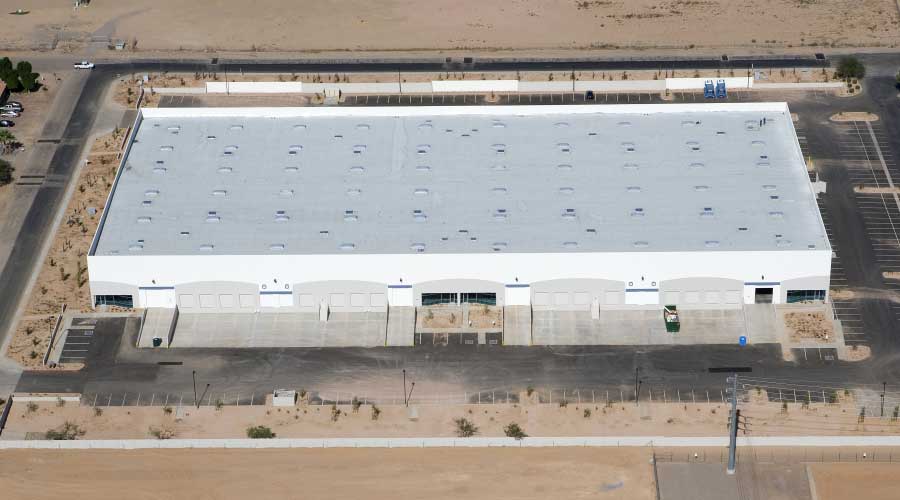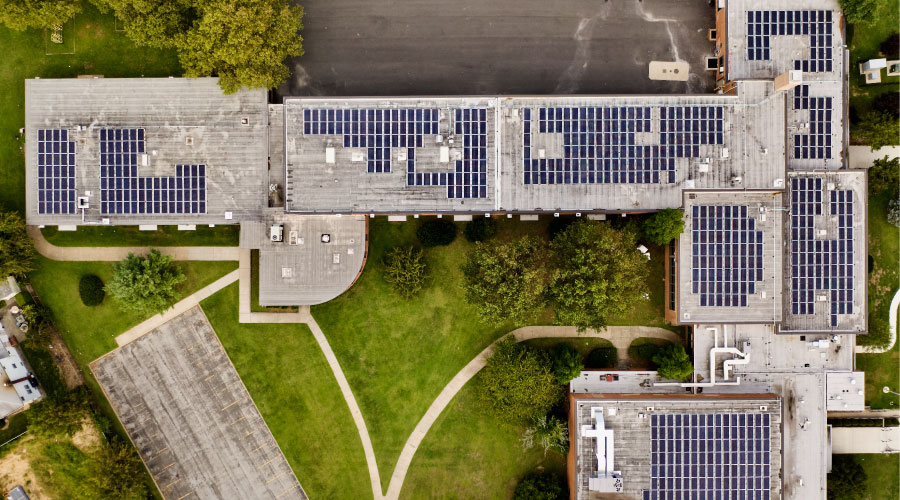Roofing Reconsidered: RoofPoint Guidelines Hone Industry's Best Practices
For many years, an environmentally responsible roof only meant one that was reflective and therefore could save owners money on air conditioning costs. Usually, that dictated a white roof.
But what works in Phoenix doesn't necessarily play in Pittsburgh, which means environmentally responsible roofing guidelines have to be both specific and geographically grounded.
The notion of responsible roofing is changing, and the Center for Environmental Innovation in Roofing's new RoofPoint program is helping lead the charge.
After unveiling preliminary guidelines late last year, a pilot program has started, and early users have noted benefits from the rating system.
Those familiar with LEED will find similarities when they examine the RoofPoint program. "We incorporated many key principles from LEED, especially in terms of original intent and overall structure," says Jim Hoff, research director of the Center.
At least initially, the pilot program differs from LEED by avoiding a weighted set of points given to projects. In the short term, the Center is recognizing projects that meet the overall intent of RoofPoint and meet or exceed a balanced selection of requirements.
Benefits of Ratings
Even without a weighting system in place, developing a rating system benefits the industry in a couple of ways, Hoff says. First, it provides a familiar-feeling template that users are accustomed to. Second, while the LEED program drives environmental guidelines in a general sense, industry-specific groups can often hone specifications to a fine edge, achieving a level of detail that generalist specifications can't.
And, as with most things, the devil is in the details. "LEED tends to assume best construction practice will be followed," says Hoff. But he adds that the roofing industry is a little more skeptical, especially because it's an industry where the lowest bid often wins.
"As a result, roofing assemblies are frequently driven by value engineering and first cost. Best practice cannot always be assumed," he says.
In addition, the RoofPoint pilot program also includes one important segment of facility projects that might be overlooked by a traditional, LEED-only approach: re-roofing.
Because 2.5 to 3 billion square feet of roofing projects each year are re-roofing jobs, RoofPoint credits are available for existing buildings.
"Three out of every four roofing jobs are on existing buildings — not on new construction," says Hoff.
Largely, the RoofPoint program takes a practical approach to roofing practices, says Paul Mitchell, head of strategic initiatives and alliances, Tremco.
"For example, one common practice that's not always enforced are multiple layers of insulation," he says. "RoofPoint specifically calls for offset panels among multiple layers to prevent heat loss."
Another item addressed by RoofPoint — but sometimes overlooked in building codes — is that R-values are not a constant. Rather, R-values shift as the temperature changes and are altered by ambient humidity.
"By increasing insulation, you're compensating for the chemistry of the application," Mitchell says. "And [RoofPoint] also categorizes the cool roof to be given credit only in hotter climates."
Pilot project members are aware of these nuances, say experts. By definition, early adopters of the RoofPoint guidelines are environmentally minded, and choose traits like durability, high thermal values or lifecycle cost, rather than lowest first costs.
Pilot Projects
Make no mistake, participants in RoofPoint's pilot program like to save money. But first-cost considerations aren't the only option.
Todd Kaska, vice president for strategic accounts at D.C. Taylor Co., recently used RoofPoint for a project at Meridian Vineyards in Paso Robles, Calif.
"We evaluated the Meridian project with the RoofPoint criteria for several reasons," Kaska says. "Meridian, like many other wineries, is highly sophisticated in its approach to sustainability."
In addition, Kaska says, the RoofPoint evaluation criteria provides Meridian with a method to document and measure decisions for developing projects as it relates to maintaining or replacing their roofs.
Echoing Hoff's sentiments about a significant benefit of RoofPoint, Kaska also says that the RoofPoint program provides a method of documentation that LEED does not provide in making decisions regarding existing facilities.
Finally, for both the Meridian project and other D.C. Taylor projects, Kaska says that the evaluation criteria allow his company to better document recycling and waste diversion.
Indeed, material re-use is an important consideration for some facility managers. It was for Tremco when —as part of the RoofPoint pilot project — the company re-roofed its corporate headquarters.
Among the many other highlights of the project, waste from the re-roofing job was used to patch areas of the company's asphalt parking lot.
The project, says Mitchell, provided the company with the ability and first-hand knowledge to prove that sustainable choices really do make a difference.
Hoff says he anticipates that future users of RoofPoint, at least initially, will be REITs, forward-looking corporate campuses and academic institutions.
"Many large corporations have sustainability officers, and they're the kinds of organizations that realize the value of RoofPoint," Hoff says.
Admittedly, staying ahead of the environmental curve can be a tough task, fraught with false starts and dead ends, especially when "new" technologies and guidelines always seem to crop about six months after a re-roofing project.
But initial results bode well. For the Tremco property, the company used an intensive vegetative roof, curtailing the heat island effect, nearly eliminating storm water runoff (which is used to maintain rooftop vegetation and some grade-level site landscaping via the water collection and storage system) and — according to preliminary reports — enhancing avian habitat.
And, partly by re-using some materials to patch the parking lots, the company succeeded in nearly eliminating solid waste generation.
Another aim of RoofPoint is to guide a long-term view for the roofing industry and its customers.
Near term, that meant installing a renewable-energy-ready deck on the top of the Tremco building. According to Mitchell, its presence anticipates future clean-energy generation solutions.
Long-term View
Looking farther into the future, many facility managers understand that a price will be attached to carbon. "As of today, all you can do is speculate," Hoff says. "We don't have a way to factor carbon into our economic calculations."
But increasingly it seems that facility managers have to be mindful of their carbon footprint when selecting all materials and systems — including roofing.
"Building owners might have to get used to asking what ‘the 60-year cost' is, or ‘what the cost is at X dollars per ton' for carbon," Hoff says. "Many sustainable practices really only make sense on an extended life-cycle basis."
Still, few facility managers will jump up and down with excitement when facing a re-roofing project. Tear-offs and re-installs can be messy, disruptive and costly. Nevertheless, a high-performing roof is vital to a facility, and a high-performing roof that is maximized with evaluation criteria like RoofPoint will pay dividends down the road.
About the Center
Headquartered in Washington, D.C., the Center for Environmental Innovation in Roofing is a non-profit roofing organization formed by members of the National Roofing Contractors Association. The organization serves to educate its members and the industry on environmental stewardship and provide information on sustainable roofing. The Center also encourages product innovation and works with academia to provide a forum for ongoing roofing research.
The Center's research and information products are designed to help guide members' business decisions, improve the roofing industry's policy and regulatory environment, and educate consumers about environmentally friendly roofing options.
In addition, the Center works to expand market opportunities for its member contractors, design consultants and manufacturers. It also performs advocacy on the industry's behalf related to energy efficiency and renewable energy roofing technologies. Finally, it helps coordinate U.S. and international standards and codes. |
RoofPoint: Purpose & Specifications
According to the Center for Environmental Innovation in Roofing, the mission of RoofPoint is to provide a roof-system selection program, regardless of membrane types and system designs.
The RoofPoint system is organized into five areas that represent the primary environmental contributions of modern low-slope roofing systems:
- Energy Management
- Materials Management
- Water Management
- Durability / Life Cycle Management
- Environmental Innovation in Roofing
The Center then takes each of those areas and evaluates the primary environmental functions. Credit is awarded to installations using the following considerations:
- Meets Intent. In the opinion of the evaluator, the project fulfills the broad intent of the credit, although specific conditions of the project do not support full compliance with the credit requirement.
- Meets Requirement. In the opinion of the evaluator, the roof system meets the credit requirement.
- Exceeds Requirement. In the opinion of the evaluator, the roof system substantially exceeds the credit requirement and provides a tangible benefit by exceeding the requirement.
- Not Applicable. In the opinion of the evaluator, the credit does not provide a suitable measure of sustainability for the roof system being evaluated.
Although the final published version of RoofPoint might use a weighting or point system, the pilot program uses those qualitative evaluations.
|
Testing the Future
To help evaluate current heat-island theories and give greater visibility to roofing projects, Scalo Solar recently installed a $1 million project on its Pittsburgh rooftop using RoofPoint guidelines.
Designed as a demonstration project, it includes a 105 kW roof-mounted solar array that includes three different technologies — polycrystalline panels, thin film and glass tube. A portion of the polycrystalline panel technology will be surrounded by green vegetative roofing with moss matting used under the panels to study the ambient air temperature differences and their effect on panel performance. Each system's energy production will be monitored separately as will the installation and roofing amendment costs. In the case of energy production, monitoring is achieved in real-time.
|
Related Topics:











